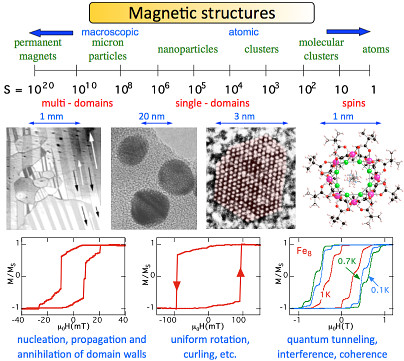Introduction
The interface between classical and quantum physics has always been an interesting area, but its importance has nevertheless grown with the current explosive thrusts in nanoscience. Taking devices to the limit of miniaturization (the mesoscale and beyond) where quantum effects become important makes it essential to understand the interplay between the classical properties of the macroscale and the quantum properties of the microscale.
|
|
| Fig.:Scale of size that goes from macroscopic down to nanoscopic sizes. The unit of this scale is the number of magnetic moments in a magnetic system (roughly corresponding to the number of atoms). The hysteresis loops are typical examples of magnetization reversal via nucleation, propagation, and annihilation of domain walls (left), via uniform rotation (middle), and via quantum tunneling (right). |
In order to put our research activities into perspective, let us consider Fig. 1 which presents a scale of size ranging from macroscopic down to nanoscopic sizes. The unit of this scale is the number of magnetic moments in a magnetic system. At macroscopic sizes, a magnetic system is described by magnetic domains that are separated by domain walls. Magnetization reversal occurs via nucleation, propagation, and annihilation of domain walls (see the hysteresis loop on the left) which was measured on an individual elliptic Co particle. When the system size is of the order of magnitude of the domain wall width or the exchange length, the formation of domain walls requires too much energy. Therefore, the magnetization remains in the so-called single-domain state. Hence, the magnetization might reverse by uniform rotation, curling or other nonuniform modes (see hysteresis loop in the middle ). Molecular nanomagnets (also called single-molecule magnets) are the final point in the series of smaller and smaller units from bulk matter to atoms. Up to now, they have been the most promising candidates for observing quantum phenomena because they have a well-defined structure with well-characterized spin ground state and magnetic anisotropy.
Reference:
Wernsdorfer, W.
Classical and quantum magnetization reversal studied in nanometer-sized particles and clusters
Advances In Chemical Physics, 118, 99-190, (2001).


